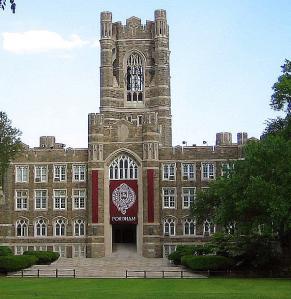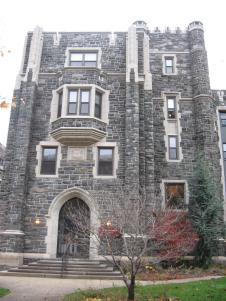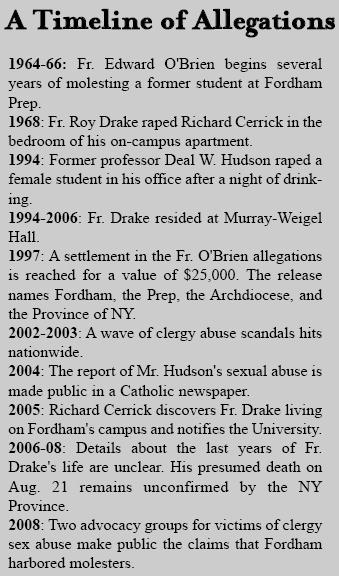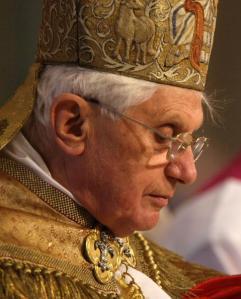|
The Silent Treatment
By Peter Mullin
In April of 1994 an 18-year-old freshman walked into the office of the Dean of Fordham College at Rose Hill, a place that, according to the University’s mission statement, concerns itself with fostering an “environment that celebrates and protects the dignity of the human person.” Inside the confines of that office the young woman started the process of protecting that dignity. She told the Dean a story of how, after a night of drinking in the city, her philosophy professor took advantage of her in his office. By the end of the semester, her professor had resigned. Ten years later that scene would come to national attention in an article by Joseph Feuerherd published in the National Catholic Reporter. The story detailed the alleged 1994 sexual misconduct of Deal W. Hudson, a top advisor to George W. Bush’s 2004 re-election campaign, while he was a tenured professor of philosophy at Fordham. That July, Fordham spokeswoman Elizabeth Schmalz issued a statement to NCR saying, “Sexual Harassment is not tolerated at Fordham University.” It continued, “Fordham followed its policy rigorously in this case and initiated an investigation into the matter upon receipt of the student’s complaint.” The Dean in the NCR article, described as “sympathetic” and giving “every indication that he believed [the girl’s] story,” was Father Joseph M. McShane, S.J., Fordham University’s current president. In 1994, it appears that he listened intently to the aggrieved student and quickly iniated actions to remove Mr. Hudson from his position. And in 2004, Father McShane presided over the University when it publicly and explicitly denounced sexual harassment after the allegations against Mr. Hudson surfaced in the media. Why then, after compassionately and publicly dealing with a case of alleged sexual harassment, did Father McShane and Fordham University take a seemingly different approach in handling another, more recent allegation of sexual abuse on campus? Why have they remained so silent? As reported in the New York Times on October 21, 2008, a pair of advocacy groups for victims of clergy sex abuse say that two Jesuits accused of molesting children were sheltered on campus well after Fordham was made aware of the situation. The groups–the Survivors Network of Those Abused by Priests and BishopAccountability.org–held a press conference on Fordham Rd. outside of Murray-Weigel Hall, the infirmary for the New York Province of the Society of Jesus. According to the organizers, that event was the first time the accusations against Rev. Eugene J. O’Brien, S.J., a former President and Principal of the Fordham Preparatory High School, and Rev. Roy A. Drake, S.J., a former science teacher at the Prep School, were made public. Father O’Brien is accused of molesting a former Fordham Prep student over a period of several years, starting when the alleged victim was a student at the high school from 1964 to 1966. The alleged victim, a 58-year-old who spoke at length to the paper on the condition of anonymity, said that the priest molested him on numerous occasions, including several of which he claims occurred during a trip through Europe with Father O’Brien and five other Prep students. “I don’t know if I was raped or penetrated, but I was violated,” Father O’Brien’s accuser told the paper. “He would jump in the bed with me and I would just shut down, close my eyes and go somewhere else,” he said of the man he recalled as “a real father figure.” After the alleged incidents of sexual molestation, the now-middle aged man said he “just repressed it all,” even to the point that he allowed Father O’Brien to perform his marriage ceremony. The alleged victim also claims to have had an encounter with Father Drake in the Fordham University Seismic Observatory, next to Freeman Hall. Inside the observatory, Father Drake attempted to molest him: “I was literally running around in circles around this table to get away from him until I could escape.” He repressed the memories until 1997, when he met a counselor for victims of clergy sex abuse who, he says, helped him go through the process of bringing his allegation to the attention of the University. “I was after an apology, some kind of an explanation to what had happened,” he said. According to a copy of a 1997 settlement available online, the ensuing lawsuit involving Father O’Brien was settled for $25,000. In addition to the Jesuit priest, the New York Province of the Society of Jesus, the Archdiocese of New York, Fordham University, and Fordham Prep were named in the settlement and released from any “past, alleged or actual, current and future liabilities.” When the paper attempted to confirm the terms of the settlement by contacting the office of Rev. Thomas R. Slon, S.J., the executive assistant to the head of the New York Jesuits who spoke with the Times, he was unavailable for comment. Peter Feuerherd, a communications consultant for the Province who spoke with the paper, said he was not familiar enough with the situation to comment. In the Times article, Father Slon would neither confirm nor deny the terms of the 1997 settlement regarding Father O’Brien. Joseph Zwilling, a spokesman for the Archdiocese of New York, when asked by the paper to confirm the terms of the settlement, said the Archdiocese “could not find anything in the files.” According to the anonymous accuser, the most emotional day of his life came when he met Father O’Brien again in 1997. At that meeting, Father O’Brien blamed his actions on alcohol abuse and would not apologize. “I wanted an admission of guilt,” the alleged victim told the paper. He says he was never concerned with taking the Jesuits down. “It’s [about] accountability,” he said. Richard Cerrick, a 53-year-old lawyer from Connecticut, claims he was raped and sodomized by Father Roy Drake in 1968. In extensive interviews with the paper, Mr. Cerrick said Father Drake provided him with alcohol and then raped him in the bedroom of the Jesuit’s apartment on Fordham’s campus when he was 13-years-old. The alleged attack occurred the night before a weekend ski trip to Hunter Mountain that the 8th grader was invited to go on by a friend who went to Fordham Prep. Though he says he was able to keep the incident secret until 2002 or 2003, when the clergy sexual abuse scandal erupted in archdioceses nationwide he says he wondered what had happened to Father Drake. In 2005, after two years of searching, Mr. Cerrick says he found Father Drake listed on the Internet as living at Murray-Weigel Hall. In October of that year, Mr. Cerrick had his attorney, Mitchell Garabedian, inform the Jesuits and Fordham University in writing of Father Drake’s presence on the campus of Fordham University. According to the advocate group Bishop-Accountability.org, Father Drake resided in Murray-Weigel from 1994 until some point in 2006. He notified the school in order “to remove Father Drake from any proximity and contact with high school and college kids,” said Mr. Cerrick. “If I can protect one, or two, or five kids, whatever ages, I would be providing a service,” he continued. In October 2007, he was assured by the head of the New York Province that “Roy Drake is not in a position of access to minors.” Though it is believed that Father Drake died this past August, the paper has been unable to ascertain exact details about his whereabouts during the final few years of his life or even a confirmation of his death. According to BishopAccountability.org, in 2006 he was transferred to a sexual abuse treatment center in Missouri. But a fall 2006 Jesuit newsletter describes Father Drake as a liaison between the residents of Murray-Weigel Hall and a construction company performing renovations. Finally, an August newsletter from the Jesuits of the Missouri Province lists Father Drake’s death as occurring on August 21 in the Bronx. But in the Times article, Father Slon of the New York Jesuits would not confirm that Father Drake had died. In April of this year, Pope Benedict XVI made his first trip to the United States. The Holy Father raised eyebrows across the country with his repeated acknowledgements of the pain and suffering that plague the many American Catholics whose lives have been affected by the clergy sexual abuse scandals of the last decade. “I am deeply ashamed and will do whatever is possible so that this does not happen in the future,” said the Pope just before landing in the United States for his April visit the BBC reported. “It is more important to have good priests than many priests. We will do everything possible to heel this wound.” In regards to the Pope’s statements in the United States, Father McShane told the Times, “None of us expected it, but everyone is grateful that he did. What he realized is that this is a pastoral visit and he must be pastor to those who are hurt most — and that is the victims.” With the Pope in town and Father McShane on the front page of the Times, Mr. Cerrick felt it was time to contact Fordham once more. In a letter obtained by the paper, dated May 8, 2008, the alleged victim asked the university president to “reach out in a pastoral and healing manner” to prove to him that his and the Holy Father’s words were more than “hollow and deceitful pronouncements.” Eight days later, Father McShane responded with a short, 58-word letter that acknowledged Mr. Cerrick’s letter, but simply referred him to his lawyer regarding “an amicable resolution of this matter.” The letter’s recipient was less than pleased. Calling the response he received “garbage,” Mr. Cerrick terms the treatment he has received from the University, Fordham Prep, and the New York Province since he first reported his incident three years ago “like ripping a scab off an old wound.” Five months later, Mr. Cerrick decided to go public with these accusations, and soon he and the leaders of his supporting advocacy groups were standing on Fordham Rd. “For three years I wanted to give Fordham, the Archdiocese, and the Jesuits every opportunity to do the right thing,” the 53-year-old man told the paper. “They have done absolutely nothing in three years.” As of press time, Fordham University has remained silent. The official university response came from Bob Howe, Fordham’s Director of Communications, who declined to comment, citing school policy. The Province and the Archdiocese have also chosen not to comment. And the office of the President of Fordham Preparatory School, Rev. Kenneth Boller, S.J., did not return the paper’s request for an interview. When the paper again attempted to contact Fordham, this time after discovering the public statement given by the school in 2004 regarding the sexual harassment allegations involving Mr. Hudson, the response was the same. “We’re not commenting,” said Mr. Howe. And thus the question remains. Why have the school and its administration chosen to handle this affair in secrecy? Why, when the university has shown in recent history an ability to openly and efficiently deal with a public situation of sexual harassment, can it not find the means to do the same in this case? Indeed, this entire ordeal raises quite a few questions about transparency in Fordham University’s administration. But from the looks of it, we’re not about to get any answers.
|
.
Any original material on these pages is copyright © BishopAccountability.org 2004. Reproduce freely with attribution.



